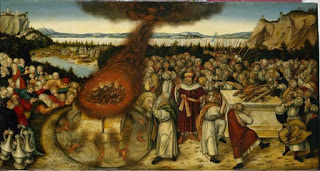The verse reads:
“And Elijah came unto all the people, and said, How long halt ye between two opinions? if the Lord be God, follow him: but if Baal, then follow him. And the people answered him not a word.”
 |
| Isaiah and the priests of Baal |
That led to the famous showdown between Elijah and the priests of Baal.
_____
One of the most fascinating elements of this passage is that the people had no answer. They didn’t know whom to follow.
Why were they so confused?
On the one hand, they had the prophet of God.
But on the other hand, they had the popular leaders, the priests of Baal who purported to speak for God, who taught the people that the prophets were wrong, just as the M2C scholars are doing today.
_____
The verse could be rephrased this way:
“And Elijah came unto all the people, and said, How long halt ye between two opinions? if the prophets be true, follow them: but if the M2C scholars [be true], then follow them. And the people answered him not a word.”
We each get to choose.
We each must choose.
[Note: the M2C intellectuals will object that I’m comparing them to the priests of Baal because they’re entire approach depends on obfuscation and confusion. True, I am comparing them to the priests of Baal, but only in a limited sense. That’s how we always apply the scriptures to our own circumstances. Here, I’m limiting the comparison to the question of whether to follow the prophets or to repudiate the prophets. I’m not comparing M2C to all the things the priests of Baal taught and practiced, but the M2C intellectuals openly try to get members of the Church to reject what the prophets have taught about the New York Cumorah.]
_____
How long will members of the Church continue to halt between the two geographical models?
It’s not a difficult choice. Whichever model you choose, you can confirm your bias by interpreting the text to match your model and by considering relevant archaeology, anthropology, geology, geography, etc. that confirms your bias.
Really, the only difference is whether you agree with or disagree with the prophets.
Either Cumorah is in New York, as the prophets have consistently and persistently taught, or it’s elsewhere, in which case it doesn’t really matter much where it is, does it?
If the prophets have been wrong all along, we might as well accept the fantasy maps currently being taught to LDS youth by CES and BYU.
Inevitably and irreversibly, that will lead to the metaphorical interpretation of the Book of Mormon, which seems to be the ultimate objective of the M2C scholars anyway (although they claim otherwise).
_____
Source: Book of Mormon Concensus
